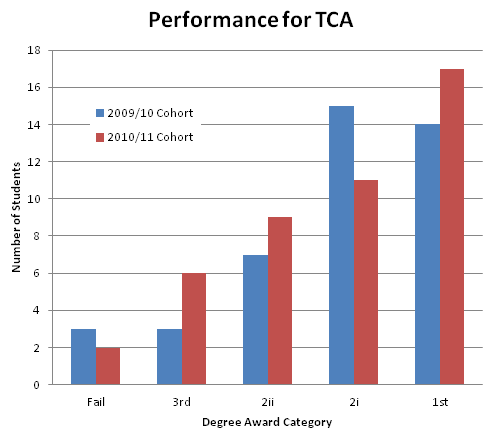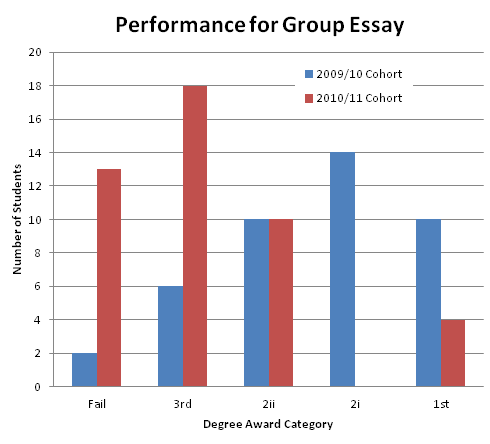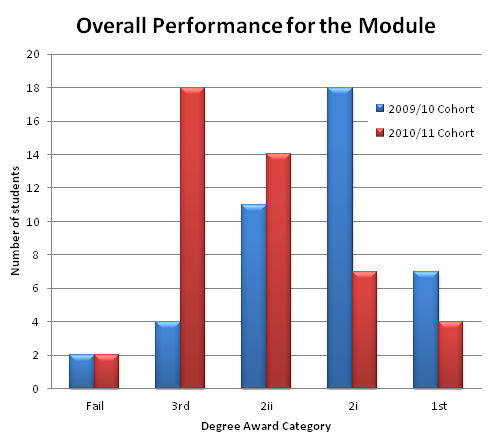An investigation into the potential for blended learning approaches in enhancing year 1 students’ assessment experience
Shaista Minhas|
and Simon Starr
Canterbury Christ Church University
Published February 2012
An abridged version of this case study was previously published in Economics Network Newsletter, Issue 17
The overall aim of the project was to assess the potential of blended learning to aid the improvement of the learning process experienced by widening participation students who had been motivated to enrol on a BSc in Business Management Degree Programme at Canterbury Christ Church University, Broadstairs Campus, and were required to take the Introduction to Economics and Statistics Module as part of their first year undergraduate programme.
“Widening Participation is central to the Mission of the University which is ‘to pursue excellence in academic and professional higher education thereby enriching both individuals and society’. This focus includes a commitment to enabling suitably qualified individuals to access the potential benefits and rewards of higher education and to fulfil their potential whatever their background.” (Canterbury Christ Church University online, 2010, p.4)[1]
Part of the widening participation strategy of Canterbury Christ Church University is the development of Broadstairs Campus. This is a satellite campus based in the regionally, economically deprived area of the Isle of Thanet. For the purpose of this project widening participation was defined as a desire “to increase the representation of those groups that are currently under-represented in higher education or in particular aspects of higher education (e.g. males in primary education or nursing). It includes a focus on students and their families from lower-socio-economic groups (NS SEC 4, 5, 6 and 7), from low income groups, those from areas of low participating neighbourhoods, disabled students, students leaving care, part-time and mature students; and some students from minority ethnic communities.” (Canterbury Christ Church University online, 2010, p.1)1 This is particularly relevant to the regional location of Broadstairs Campus, which is the Isle of Thanet because it would be considered to be a low participating neighbourhood. 12.4% of people living in the Margate District have qualifications at degree level or higher and in the Broadstairs District 16.4% have qualifications at degree level or higher, while in Canterbury, which is only 22 miles from the Isle of Thanet, 28.8% of people have qualifications at degree level or higher[2].
The module recruits from a non-traditional student base driven by the University Widening Participation Strategy1. Given the widening participation context, key challenges are support and guidance (both assessments) and time and travel for with regard to the group assignment.
Introduction to Economics and Statistics is a compulsory 20 credit module taken by all first year undergraduate students studying for a BSc in Business Management. The module aims to introduce students to basic statistical techniques which are relevant to the modern day economist. It will also enable students to acquire a knowledge and understanding of the fundamental economic concepts of microeconomics and macroeconomics. The module was assessed by a group essay which discussed the impact of the credit crunch on a region; and an hour time constrained assignment of thirty objective test questions regarding everything studied in the module. Both assessments had a weighting of 50% for the overall performance awarded for the module.
Modern economic textbooks: Begg et al. (2008)[3] and Sloman and Hinde (2006)[4] offer blended learning to engage students to obtain a more thorough understanding of the different economic concepts. For the previous cohort 2009/10, the core textbook Begg et al. (2008)3 online learning site was chosen to support students with regard to the time constrained assignment.
Three objectives were identified to explore the potential for “blended learning” approaches to enhance the students’ assessment experience, specifically in the areas of guidance and flexibility for the two assessments.
- Firstly, the introduction of the new blended learning approaches in support of the two module assessments: audio slides (PowerPoint with tutor’s narration) as additional guidance to help students better understand and prepare for both assessments, and WIMBA (a web-based videoconferencing and collaboration system) to enable greater flexibility for the students to engage in the group essay remotely rather than having to travel.
- The second objective was designed to evaluate the impact of the introduction of the two new approaches on the assessment performance and group dynamics and cohesiveness between 2009/10 and 2010/11 cohorts.
- Finally, the evaluation of 2010/11 cohort students’ perceptions, attitudes and satisfaction towards new and existing approaches with regard to the introduction of audio slides and WIMBA, and the continuation of open access to online test questions and feedback provided by the publisher of a key Economics text3 for the time constrained assignment.
The first two activities were regarding the production of the audio slides and the availability of WIMBA (a web-based videoconferencing and collaboration system) covered the first objective with regard to the introduction of the new blended learning approaches in support of the two module assessments. The third activity focused on the second and third objectives which were designed to evaluate the impact of the introduction of the two new approaches on the assessment performance and group dynamics and cohesiveness between 2009/10 and 2010/11 cohorts, and the evaluation of 2010/11 cohort students’ perceptions, attitudes and satisfaction towards the new and existing approaches with regard to the introduction of audio slides and WIMBA and the continuation of the online test questions. Therefore, the third activity evaluated the impact of new and existing blended learning approaches in support of the assessments by comparing cohort assessment performances and by surveying students.
There were 42 students in the 2009/10 cohort and 45 students in the 2010/11 cohort who studied the Introduction to Economics and Statistics Module. The methodology applied was a combination of quantitative and qualitative data gathered. The quantitative data was gathered from surveys completed by both cohorts, mapping of the movement of the group dynamics in each year, and the performance of the two cohorts through the assessments. Qualitative data was determined through interviews with students during seminar activities and individual tutorials. In order to make a valid comparison of the performance, both assessments were identical for the two cohorts.
It was argued that the quality of the production of the audio slides could be improved at the cost of a larger file. Therefore the scope for investigating the balance between sound quality and file size needed to be evaluated in the future. The overall attitude and opinions of the 2010/11 cohort were positive with regard to audio slides. Also, both cohorts agreed that the online test questions and feedback provided support for the time constrained assignment. However, the research highlighted that it could not be argued that audio slides replaced face to face guidance for assessment preparation by recording guidance in audio slides. Instead, the research suggested that audio slides complemented tutorials as discussion could be focused around the audio slides rather than replacing tutor-led support for both assignments. Also, the Higher Education Academy IMPALA[5] project found students valued the use of audio slides for revision. The opinions of the 2010/11 cohort agreed with this Project’s5 findings. However a comparison of marks between the 2009/10 cohort and the 2010/11 cohort identified there was no actual variation of marks. (See Table 1) Also the chi-squared statistically demonstrated there was no deviation of the degree award categories between the two cohorts with regard to the time constrained assignment. (See Chart: Performance for TCA and Appendix 1) Thus it could be argued that the 2010/11 cohort only perceived audio slides and online test questions did improve the learning process they experienced, but the new blended learning approach did not impact on the actual marks they achieved compared to the 2009/10 cohort.
Table 1: Time Constrained Assignment (TCA)
|
Cohort
|
TCA
|
|
2009/10 Average
|
61.79
|
|
2009/10 Standard Deviation
|
16.19
|
|
2010/11 Average
|
61.78
|
|
2010/11 Standard Deviation
|
15.82
|

The implementation of WIMBA (a web-based videoconferencing and collaboration system) proved very complex and time-consuming, even though only three groups had originally signed up to use WIMBA. It could be argued that the strength of integrating WIMBA with Blackboard VLE is in needing only a Blackboard login and not having to learn how to login to a new system on a different web site. However, without a facility through Blackboard VLE to create private, student-led group rooms this approach is impractical.
There was initial interest in using WIMBA by three groups for the group essay. However, none of the 3 groups actually followed through and used WIMBA, because they had not chosen to attend the training session offered in December 2010. Thus this resulted in the students not effectively using WIMBA. The students stated they were unable to properly access the group WIMBA classroom for collaborative assignment work. It could be argued that the research illustrated that WIMBA is not designed for student-led use in group assessment work.
None of the ten groups for the 2010/11 cohort requested a tutorial with the tutor using WIMBA; instead they preferred a face-to-face tutorial where group members and the tutor were present. The research highlighted that 70% of students for the 2010/11 cohort stated they preferred to communicate in person. Some students stated that communicating on a mobile phone that had a web camera was sufficient with regard to encouraging the production of a group essay. Also for the 2010/11 cohort, some students identified that they preferred to use social network websites like Facebook or Skype to communicate with their colleagues because no prior training was required. However 88% of the same students stated they would consider using WIMBA in the future.
The research also identified that the team management skills of the 2010/11 cohort were significantly less focused on planning than their predecessors students from the 2009/10 cohort. Mapping the movement of the students between groups for the 2009/10 cohort identified that no student changed groups after the beginning of the Lent Term. However, 25% of the students had not formally identified they were in a group at the beginning of the Lent Term, and on the day the group essay was scheduled to be handed in at the end of the Lent term, a student changed groups, with regard to the 2010/11 cohort. Also there were only 10 groups in the 2010/11 cohort, which meant on average each group had 4.5 students; while there were 14 groups in the 2009/10 cohort, which meant on average each group had 3 students. Therefore, it could be argued that the groups for the 2010/11 cohort needed to communicate in person to ensure greater understanding of the construction of the group essay because they had chosen not to organise themselves at an earlier stage of the academic year and were required to communicate with a larger number of students than the previous cohort.
A comparison of the assessment performance of the 2010/11 cohort to the 2009/10 cohort with regard to the group essay demonstrated a significant variation of marks awarded with regard to the average mark, which varied by 14.67%, and the standard deviation, which varied by 4.21%. (See Table 2) The chi- squared statistically demonstrated there was a deviation of the degree award categories between the two cohorts with regard to the group essay assignment (See Chart: Performance for Group Essay and Appendix 2). Thus, it could be argued that the research identified the students for 2010/11 cohort needed to further develop their management skills before being able to successfully apply WIMBA, but they appreciated the potential of the new blended learning approach.
Table 2: Group Essay
|
Cohort
|
Essay
|
|
2009/10 Average
|
58.00
|
|
2009/10 Standard Deviation
|
16.08
|
|
2010/11 Average
|
43.33
|
|
2010/11 Standard Deviation
|
11.87
|

A comparison of the overall average marks and the respective overall standard deviations for the module showed that for the 2009/10 cohort their average mark was 7.33% higher than for the 2010/11 cohort, while the standard deviation variation was 5.70% marks less for the 2010/11 cohort than the 2009/10 cohort.(See table 3) Thus the 2009/10 cohort’s overall performance for the module was higher than the overall performance for the 2010/11 cohort (see Chart: Overall Performance of the Module), but the same number of students i.e. two failed in both cohorts. Also, the Pearson’s Product Moment Correlation Coefficient for the 2009/10 cohort was a positive 56% correlation, which was significantly higher than the correlation for the 2010/11 cohort which was only a weak positive 20% correlation. Therefore, it could be argued that the performance of the students in the 2009/10 cohort for the two assessments had a higher degree of determining similar marks for the time constrained assignment and the group essay, than the students’ performance for the 2010/11 cohort.
Table 3: Marks for the Module
|
Cohort
|
Overall
|
|
2009/10 Average
|
59.89
|
|
2009/10 Standard Deviation
|
14.26
|
|
2010/11 Average
|
52.56
|
|
2010/11 Standard Deviation
|
10.78
|

Thus, overall it could be argued that the research identified that 2010/11 cohort perceived that audio slides did make a positive contribution to their understanding of the module. However, this perception was not reflected in their overall grades, which on average were 7.33% lower than the 2009/10 cohort. Also, the students stated a preference for face –to-face communication with regard to the group essay. Those students who did use online forms of communication in their groups preferred to apply familiar external technologies i.e. a mobile phone and Facebook. However, a more structured tutor-led WIMBA would be considered by the students in their future studies. Thus, it could be argued that there was no overall quantifiable impact of the new blended learning approaches to the actual performance for the 2010/11 cohort with regard to the two assessments. However, the students’ perceptions of the new blended learning approaches were positive and therefore could be argued to have enhanced the students’ assessment experience.
Appendix 1: Chi-squared for TCA
Table: Time constrained assignment
|
Degree Awards Categories
|
Fail
|
3rd
|
2ii
|
2i
|
1st
|
|
2009/10 Cohort
|
3
|
3
|
7
|
15
|
14
|
|
2010/11 Cohort
|
2
|
6
|
9
|
11
|
17
|
H0: There is no association between the cohort and the degree award categories
H1: There is an association between the cohort and the degree award categories
Chi-squared statistic was 2.25494
With 4 degrees of freedom the critical value is 9.488
2.25494 is less than 9.488.
Therefore accept H0. There is no statistical association between the cohort and the degree award categories for the time constrained assignment.
Appendix 2: Chi-squared for Group Essay
Table: Group Essay Assignment
|
Degree Awards Categories
|
Fail
|
3rd
|
2ii
|
2i
|
1st
|
|
2009/10 Cohort
|
2
|
6
|
10
|
14
|
10
|
|
2010/11 Cohort
|
13
|
18
|
10
|
0
|
4
|
H0: There is no association between the cohorts and the degree award categories
H1: There is an association between the cohorts and the degree award categories
Chi-squared statistic was 30.571
With 4 degrees of freedom the critical value is 9.488
30.572 is greater than 9.488
Therefore reject H0 and accept H1. There is a statistical association between the cohort and the degree award categories for the group essay.
[1] Canterbury Christ Church University Widening Participation Strategic Assessment 2009 -2012. Available at:
http://www.canterbury.ac.uk/support/partnerships-widening-participation/documents.asp (Accessed: 22 Mar 2010)
[2] Office for National Statistics. Available at: http://www.statistics.gov.uk (Accessed: 22 Mar 2010)
[3] Begg, D., Fischer, S. And Dornbusch, R. (2008) Economics McGraw Hill
[4] Sloman, J. and Hinde, K. (2006) Economics for Business Prentice Hall
[5] HEA IMPALA Project - The Use of Podcast to Provide Lecture Recordings (2007). Available at: http://www.impala.ac.uk/outputs/examplars/ (Accessed: 9 May 2011)
